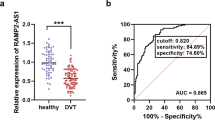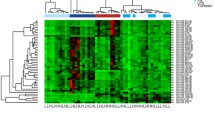Abstract
Coronary collaterals can effectively improve myocardial blood supply to the area of CTO (chronic total coronary occlusion) and can, thus, reduce infarct size. LUNAR1(leukemia-induced noncoding activator RNA-1) is a specific LncRNA regulated by Notch signaling that not only can enhance the expression of IGFR-1 but also can promote angiogenesis and cell survival. Here, we investigated the relationship between LncRNA-LUNAR1 levels in peripheral plasma and the formation of coronary collaterals. In total, 172 patients with CTO were enrolled and followed up for 12 months. Coronary collaterals were scored according to the Rentrop scoring system. Preclinical tests of tube formation were used to address the mechanisms behind the association between LncRNA-LUNAR1 and development of collaterals. Clinical data and inflammatory factors, including comorbidity, CD14++CD16− monocytes, and CCL2 (chemokine motif ligand 2), were compared and analyzed. Real-time PCR was used to detect the expression of LncRNA-LUNAR1 in peripheral blood plasma. The Rentrop score was positively correlated with LncRNA-LUNAR1 levels in patients with CTO (R = 0.47, p < 0.001). Tube formation assay proved the direct association between LncRNA-LUNAR1 and development of collaterals (p = 0.011). The univariate Kaplan–Meier analysis revealed that patients with low LncRNA-LUNAR1 expression exhibited worse clinical outcomes than those with high LncRNA-LUNAR1 levels (p = 0.008). Receiver operating characteristic (ROC) curve and correlation analysis further confirmed that LncRNA-LUNAR1 expression was closely related to chronic inflammatory diseases, especially diabetes (area = 0.644, p = 0.001; 95% CI, 0.562–0.726). Furthermore, both CD14++CD16− monocytes (r = − 0.37; p < 0.001) and CCL2 levels (r = − 0.35; p < 0.001) negatively affected the expression of LncRNA-LUNAR1. LncRNA-LUNAR1 expression was positively correlated with coronary collaterals in patients with CTO. Inflammatory factors, including CD14++CD16− monocytes and CCL2, may be risk factors affecting LncRNA-LUNAR1 expression.




Similar content being viewed by others
Abbreviations
- CTO :
-
chronic total coronary occlusion
- LUNAR1 :
-
leukemia-induced noncoding activator RNA-1
- LncRNA :
-
long-chain noncoding RNA
- IGFR-1 :
-
insulin-like growth factor receptor-1
- CCL2 :
-
chemokine motif ligand 2
- EPCs :
-
endothelial progenitor cells
- MALAT1 :
-
metastasis-associated lung adenocarcinoma transcript 1
- MEG3 :
-
maternally expressed 3
- HOTAIR :
-
HOX transcript antisense RNA
- eGFR :
-
estimated glomerular filtration rate
- CTP :
-
Child–Turcotte–Pugh
- PCI :
-
percutaneous coronary intervention
- TIMI :
-
thrombolysis in myocardial infarction
- hs-CRP :
-
hypersensitive C-reactive protein
- BNP :
-
brain natriuretic peptide
- GAPDH :
-
glyceraldehyde-3-phosphate dehydrogenase
- LDL :
-
low-density lipoprotein
- LvEF :
-
left ventricular ejection fraction
- T2DM :
-
diabetes mellitus type 2
- ROC :
-
receiver operating characteristic curve
- CAD :
-
coronary artery disease
- MI :
-
myocardial infarction
- MACEs :
-
major adverse cardiovascular events
- STAT :
-
signal transducers and activators of transcription
- STEMI :
-
ST elevation myocardial infarction
References
Pries, A. R., Badimon, L., Bugiardini, R., et al. (2015). Coronary vascular regulation, remodelling, and collateralization: mechanisms and clinical implications on behalf of the working group on coronary pathophysiology and microcirculation. European Heart Journal, 36(45), 3134–3146.
Khand, A., Fisher, M., Jones, J., et al. (2013). The collateral circulation of the heart in coronary total arterial occlusions in man: systematic review of assessment and pathophysiology. American Heart Journal, 166(6), 941–952.
Goldberg, L., Tirosh-Wagner, T., Vardi, A., et al. (2018). Circulating microRNAs: a potential biomarker for cardiac damage, inflammatory response, and left ventricular function recovery in pediatric viral myocarditis. Journal of Cardiovascular Translational Research, 11(4), 319–328.
Fuschi, P., Maimone, B., Gaetano, C., et al. (2019). Noncoding RNAs in the vascular system response to oxidative stress. Antioxidants & Redox Signaling, 30(7), 992–1010.
McAninch, D., Roberts, C. T., & Bianco-Miotto, T. (2017). Mechanistic insight into long noncoding RNAs and the placenta. International Journal of Molecular Sciences, 18(7), 1371.
Bolha, L., Ravnik-Glavač, M., & Glavač, D. (2017). Long noncoding RNAs as biomarkers in cancer. Disease Markers, 2017, 7243968.
Shen, S., Jiang, H., Bei, Y., et al. (2017). Long non-coding RNAs in cardiac remodeling. Cellular Physiology and Biochemistry, 41(5), 1830–1837.
Trimarchi, T., Bilal, E., Ntziachristos, P., et al. (2014). Genome-wide mapping and characterization of notch-regulated long noncoding RNAs in acute leukemia. Cell, 158(3), 593–606.
McCarter, A. C., Wang, Q., & Chiang, M. (2018). Notch in leukemia. Advances in Experimental Medicine and Biology, 1066, 355–394.
Durinck, K., Wallaert, A., Van de Walle, I., et al. (2014). The notch driven long non-coding RNA repertoire in T-cell acute lymphoblastic leukemia. Haematologica, 99(12), 1808–1816.
Kumar, M. M., & Goyal, R. (2017). LncRNA as a therapeutic target for angiogenesis. Current Topics in Medicinal Chemistry, 17(15), 1750–1757.
Roller, F. C., Harth, S., Rixe, J., et al. (2016). Development and suggestion of a cardiac CTA scoring system for the prediction of revascularization success in chronic Total occlusions (CTO) of the coronary arteries. Rofo, 188(2), 172–178.
Khatri, J., Abdallah, M., & Ellis, S. (2017). Management of coronary chronic total occlusion. Cleveland Clinic Journal of Medicine, 84(12 Suppl 3), 27–38.
Tajti, P., Burke, M. N., Karmpaliotis, D., et al. (2018). Update in the percutaneous management of coronary chronic total occlusions. JACC. Cardiovascular Interventions, 11(7), 615–625.
Rentrop, K. P., Cohen, M., Blanke, H., et al. (1985). Changes in col- lateral channel filling immediately after controlled coronary artery occlusion by an angioplasty balloon in human subjects. Journal of the American College of Cardiology, 5, 587–592.
Sari, I., Aykent, K., Davutoglu, V., et al. (2015). Association of male pattern baldness with angiographic coronary artery disease severity and collateral development. Netherlands Heart Journal, 23(5), 265–274.
Weidner, K., Behnes, M., Schupp, T., et al. (2018). Type 2 diabetes is independently associated with all-cause mortality secondary to ventricular tachyarrhythmias. Cardiovascular Diabetology, 17(1), 125.
Hansson, G. K., Libby, P., & Tabas, I. (2015). Inflammation and plaque vulnerability. Journal of Internal Medicine, 278(5), 483–493.
Rai, V., & Agrawal, D. K. (2017). The role of damage- and pathogen-associated molecular patterns in inflammation-mediated vulnerability of atherosclerotic plaques. Canadian Journal of Physiology and Pharmacology, 95(10), 1245–1253.
Dash, D. (2018). Interventional management of “balloon-uncrossable” coronary chronic total occlusion: is there any way out? Korean Circulation Journal, 48(4), 277–286.
Jeroudi, O. M., Alomar, M. E., Michael, T. T., et al. (2014). Prevalence and management of coronary chronic total occlusions in a tertiary veterans affairs hospital. Catheterization and Cardiovascular Interventions, 84, 637–643.
Karjalainen, P. P., & Nammas, W. (2017). Percutaneous revascularization of coronary chronic total occlusion: toward a reappraisal of the available evidence. Journal of Cardiology, 69(6), 799–807.
Jang, W. J., Yang, J. H., Choi, S. H., et al. (2015). Long-term survival benefit of revascularization compared with medical therapy in patients with coronary chronic total occlusion and well-developed collateral circulation. JACC: Cardiovascular Interventions, 8, 271–279.
Werner, G. S. (2014). The role of coronary collaterals in chronic total occlusions. Current Cardiology Reviews, 10(1), 57–64.
Panahi, M., Papanikolaou, A., Torabi, A., et al. (2018). Immunomodulatory interventions in myocardial infarction and heart failure: a systematic review of clinical trials and meta-analysis of IL-1 inhibition. Cardiovascular Research, 114(11), 1445–1461.
Lu, W., He, X., Su, L., & Miao, J. (2019). Long noncoding RNA-CERNA1 stabilized atherosclerotic plaques in apolipoprotein E−/− mice. Journal of Cardiovascular Translational Research, 12(5), 1–10.
Kaur, R., Kaur, M., & Singh, J. (2018). Endothelial dysfunction and platelet hyperactivity in type 2 diabetes mellitus: molecular insights and therapeutic strategies. Cardiovascular Diabetology, 17(1), 121.
Einarson, T. R., Acs, A., Ludwig, C., et al. (2018). Prevalence of cardiovascular disease in type 2 diabetes: a systematic literature review of scientific evidence from across the world in 2007-2017. Cardiovascular Diabetology, 17(1), 83.
Peng, W., & Feng, J. (2016). Long noncoding RNA LUNAR1 associates with cell proliferation and predicts a poor prognosis in diffuse large B-cell lymphoma. Biomedicine & Pharmacotherapy, 77, 65–71.
Yamamoto, H., Yoshida, N., Shinke, T., et al. (2018). Impact of CD14++CD16+ monocytes on coronary plaque vulnerability assessed by optical coherence tomography in coronary artery disease patients. Atherosclerosis., 269, 245–251.
Loperena, R., Van Beusecum, J. P., Itani, H. A., et al. (2018). Hypertension and increased endothelial mechanical stretch promote monocyte differentiation and activation: roles of STAT3, interleukin 6 and hydrogen peroxide. Cardiovascular Research, 114(11), 1547–1563.
Lu, W., Zhang, Z., Fu, C., & Ma, G. (2015). Intermediate monocytes lead to enhanced myocardial remodelling in STEMI patients with diabetes. International Heart Journal, 56(1), 22–28.
Funding
This study was financially supported by the Science and Technology Project of Nanjing (No. 201803076), the National Natural Science Foundation of China (81670326), and the Youth Medical Talents Project of Jiangsu Province (No. QNRC2016814).
Author information
Authors and Affiliations
Contributions
Conceived and designed the experiments: Wenbin Lu and Qiming Dai. Performed the experiments: Ziwei Zhang, Jian Huang, Zulong Sheng, and Lijuan Chen. Analyzed the data and wrote the paper: Zulong Sheng, Ziwei Zhang, and Wenbin Lu. Contributed reagents/materials/analysis tools: Jiandong Ding and Genshan Ma. All the authors listed have approved the manuscript that is enclosed.
Corresponding authors
Ethics declarations
Ethics Approval and Consent to Participate
This program was approved by the Ethical Committee of ZhongDa Hospital affiliated with Southeast University, China. All participants provided written informed consent.
Conflict of Interest
The authors declare that they have no conflict of interest.
Additional information
Associate Editor Craig M. Stolen oversaw the review of this article
Publisher’s Note
Springer Nature remains neutral with regard to jurisdictional claims in published maps and institutional affiliations.
Electronic supplementary material
ESM 1
(DOCX 865 kb)
Rights and permissions
About this article
Cite this article
Lu, W., Sheng, Z., Zhang, Z. et al. LncRNA-LUNAR1 Levels Are Closely Related to Coronary Collaterals in Patients with Chronic Total Coronary Occlusion. J. of Cardiovasc. Trans. Res. 13, 171–180 (2020). https://doi.org/10.1007/s12265-019-09917-x
Received:
Accepted:
Published:
Issue Date:
DOI: https://doi.org/10.1007/s12265-019-09917-x




